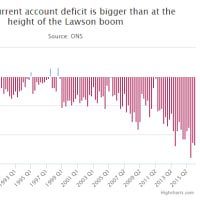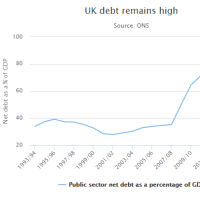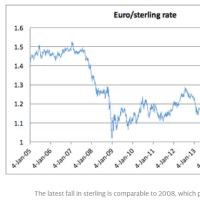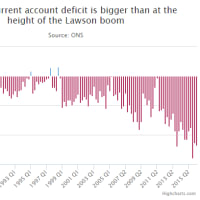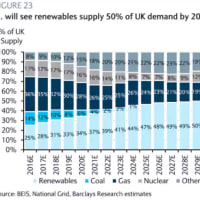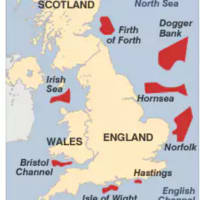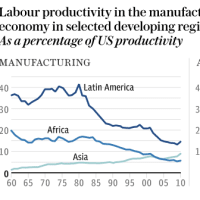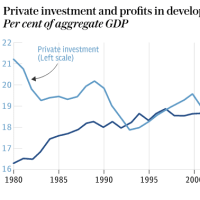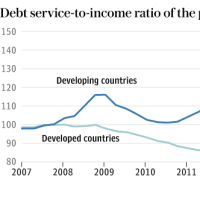Saudis risk playing with fire in shale-price showdown as crude crashes
(原油暴落:シェールお値段対決でサウジアラビアが火遊び)
By Ambrose Evans-Pritchard
Telegraph: 4:49PM GMT 30 Nov 2014


(原油暴落:シェールお値段対決でサウジアラビアが火遊び)
By Ambrose Evans-Pritchard
Telegraph: 4:49PM GMT 30 Nov 2014
A deep slump in prices might heighten geostrategic turmoil across the Middle East
原油価格大暴落で中東全域の地政学的大混乱に燃料投下となるかも。
Saudi Arabia and the core Opec states are taking an immense political gamble by letting crude oil prices crash to $66 a barrel, if their aim is to shake out the weakest shale producers in the US. A deep slump in prices might equally heighten geostrategic turmoil across the broader Middle East and boomerang against the Gulf's petro-sheikhdoms before it inflicts a knock-out blow on US rivals.
サウジアラビアとOPEC主要加盟国の狙いが米国の弱小シェール業者潰しなら、彼らは原油価格が1バレル66ドルまで暴落するのを放置プレーして、絶大な政治ギャンブルをやらかしていることになります。
原油価格の大暴落はより広範な中東全域の地政学的大混乱にも同じように燃料を投下することになりかねず、ひいては米国のライバルをKOする前に湾岸産油王国に仇するブーメランになりかねません。
Caliphate leader Abu Bakr al-Baghdadi has already opened a "second front" in North Africa, targeting Algeria and Libya – two states that live off energy exports – as well as Egypt and the Sahel as far as northern Nigeria. "The resilience of US shale may prove greater than the resilience of Opec," said Alistair Newton, head of political risk at Nomura.
イスラム国のリーダー、アブバクル・バグダディは既に、アルジェリアとリビアというエネルギー輸出で生活する二ヶ国を狙って、北アフリカで「第2の戦線」を開いていますし、エジプトとサヘル、遠くはナイジェリア北部にも進出しています。
「米シェールの耐久力はOPECより強いって証明されちゃうかもー」と野村證券の政治リスク担当部長、アリスター・ニュートン氏は言いました。
Chris Skrebowski, former editor of Petroleum Review, said the Saudis want to cut the annual growth rate of US shale output from 1m barrels per day (bpd) to 500,000 bpd to bring the market closer to balance. "They want to unnerve the shale oil model and undermine financial confidence, but they won't stop the growth altogether," he said.
ペトローリウム・レビューの元編集者、クリス・スクレボウスキー氏は、サウジアラビアはもうちょっとマーケットのバランスを取るために、米シェールの年間増産量を100万BPDから50万BPDまで減らしたいんだよね、と言いました。
「あいつらシェール・オイル・モデルを狼狽させて財界の信頼を弱めたいんだけど、完全に成長を止めるとかないから」だそうです。
There is no question that the US has entirely changed the global energy landscape and poses an existential threat to Opec. America has cut its net oil imports by 8.7m bpd since 2006, equal to the combined oil exports of Saudi Arabia and Nigeria.
米国が世界のエネルギー情勢を丸っと変えてしまった上にOPECの存在を脅かしている、というのは間違いありません。
米国の石油輸入量は2006年比-870万BPDで、これはサウジアラビアとナイジェリアの合計輸出量に相当します。
The country had a trade deficit of $354bn in oil and gas as recently as 2011. Citigroup said this will return to balance by 2018, one of the most extraordinary turnarounds in modern economic history.
この国はつい2011年まで石油とガスの輸入で3,540億ドルもの貿易赤字を垂れ流していたんですけどね。
シティグループに言わせれば、これは2018年までに均衡状態に戻るだろうとのことですが、現代経済史上で一番とんでもない大逆転の一つであります。
"When it comes to crude and other hydrocarbons, the US is bursting at the seams," said Edward Morse, Citigroup's commodities chief. "This situation is unlikely to stop, even if prevailing prices for oil fall significantly. The US should become a net exporter of crude oil and petroleum products combined by 2019, if not 2018."
「原油とかなんとかの炭化水素に関しちゃ、米国はもうジャブジャブのジャブジャブだね」とシティグループのコモディティーズ・チーフ、エドワード・モース氏は言います。
「この状況は止まらなさそうだよねー…たとえ石油の値段がごーんと下がっても。米国は2019年までに原油と石油精製品の輸出国になるんじゃないの?2018年までになってなけりゃだけど」
Opec has misjudged the threat. As late as last year, it was dismissing US shale as a flash in the pan. Abdalla El-Badri, the group's secretary-general, still insists that half of all US shale output is vulnerable below $85.
OPECはこの脅威をミスジャッジしました。
つい去年まで、米国のシェールなど恐れるに足らずと無視してましたからね。
アブドラ・サレム・バドリ事務局長なんて未だに、米シェール産出量の半分は85ドルを切ったらヤバいんだから!と言い張ってますし。
This is bravado. US producers have locked in higher prices through derivatives contracts. Noble Energy and Devon Energy have both hedged over three-quarters of their output for 2015.
これは強がり。
米国の生産者はデリバティブ契約結んで、もっと高い価格を確保してますから。
ノーブル・エナジーとデボン・エナジーなんて、2015年の生産の4分の3をヘッジ済ですよ。
Pioneer Natural Resources said it has options through 2016 covering two- thirds of its likely production. "We can produce down to $50 a barrel," said Harold Hamm, from Continental Resources. The International Energy Agency said most of North Dakota's vast Bakken field "remains profitable at or below $42 per barrel. The break-even price in McKenzie County, the most productive county in the state, is only $28 per barrel."
パイオニア・ナチュラル・リゾーシズ曰く、想定される生産量の3分の2を2016年一杯カバーするオプションを手配済みだそうで。
コンチネンタル・リゾーシズのハロルド・ハム氏なんて、「50ドルまでOK」と仰ってますよ。
IEAは、ノースダコタにある巨大なバッケン油田の殆どは「42ドルでもそれを切っても儲けが出るよ。マッケンジー・カウンティっていう州で一番生産的なカウンティのブレークイーブン価格はたったの28ドルだよ」と言ってます。
Efficiency is improving and drillers are switching to lower-cost spots, confronting Opec with a moving target. "The (price) floor is falling and may not be nearly as firm as the Saudi view assumes," said Citigroup.
効率性は上昇中だし、業者はもっと低コストなところへ移動中だしで、動く標的でOPECに対峙しています。
「底(値)なしだし…サウジアラビアの見込みは相当甘いかもね」とシティグループ。
Mr Morse says the "full cycle" cost for shale production is $70 to $80, but this includes the original land grab and infrastructure. "The remaining capex required to bring on an additional well is far lower, and could be as low as the high-$30s range," he said.
モース氏によれば、シェールの「フル・サイクル」コストは70-80ドルだそうですが、これにはそもそもの土地購入やらインフラやらが含まれています。
「新しい油井に乗っけなきゃならないCAPEX残高は遥かに少ないから。30ドル後半とか行けるんじゃない」なんておっしゃってます。
Critics of US shale may have misunderstood its economics. There is a fast decline in output from new wells but this is offset by a "long-tail phase" for a growing number of legacy wells. The Bakken field has already reached 1.1m bpd, and this is expected to double again over the next five years.
米シェールの批判者はそのエコノミクスを誤解してるのかもしれませんよ。
新しい油井の生産量は急速に減っていますけど、でも、これは既存油井の数が増える「ロングテール・フェーズ」でオフセットされるし。
バッケン油田なんて既に110万BPD達成ですし、これは今後5年間にまた倍増すると予測されてますから。
Other oil projects around the world may be more vulnerable to a price squeeze, including the North Sea, the ultra-deepwater ventures in the Atlantic off Brazil and Angola, Canadian oil sands, or Russia's contentious plans for the Arctic in the "High North". But the damage will be gradual.
世界中で起こっている他の石油開発プロジェクトの方がもっと価格圧力に弱いかもしれませんよ…北海油田とか、ブラジルとアンゴラの大西洋沖合でやってる超深海油田開発とか、カナダのオイルサンドとか、問題になってるロシアの北極圏「極北」開発とか。
でも、ダメージはじょじょにじわじわ出てくるんでしょ。
In the meantime, oil below $70 is already playing havoc with budgets across the global petro-nexus. The fiscal break-even cost is $161 for Venezuela, $160 for Yemen, $132 for Algeria, $131 for Iran, $126 for Nigeria, and $125 for Bahrain, $111 for Iraq, and $105 for Russia, and even $98 for Saudi Arabia itself, according to Citigroup.
さて、70ドルを切ってることで既に世界中の産油国組が大変なことになっています。
財政ブレークイーブンコストはベネズエラが161ドル、イエメンが160ドル、アルジェリアが132ドル、イランが131ドル、ナイジェリアが126ドル、バーレーンが125ドル、イラクが111ドル、ロシアが105ドル、そしてサウジアラビアが98ドルなんだそうです(シティグループ調べ)。
Opec may not be worried about countries such as Nigeria, but even there a full-blown economic and political crisis could turn the north into a Jihadi stronghold under Boko Haram.
OPECはナイジェリアみたいな国については心配していないかもしれませんけど、あそこですら政治経済危機で北部がボコ・ハラムのジハード帝国になっちゃうかも。
The growing Jihadi movements in the Maghreb – combining with events in Syria and Iraq – clearly pose a first-order security threat to the Saudi regime itself.
マグレブで酷くなるジハード・ムーブメント(シリアとイラクでの事件と合わせて)は明らかに、サウジアラビアの体制そのものにとって第一級の脅威ですよね。
The Libyan city of Derna is already in the hands of the Salafist group Ansar al-Shariah and has pledged allegiance to Islamic State. Terrorist movements in the Egyptian Sinai have also rallied to the black and white flag of IS, prompting Egypt's leader Abdel al-Sisi to call last week for a "general mobilisation" of all leading Arab and Western powers to defeat the spreading movement.
リビアの町、ダルナはもうサラフィスト・グループのアンサール・アル・シャリーアの手に落ちていますし、イスラム国との同盟を宣言しています。
エジプト、シナイ半島ではテロ組織がISの白黒旗の下にはせ参じ、エジプトのアブドル・アッ=シーシー大統領は先週、ムーブメントの拡大を阻止するためにアラブと西側の全ての主要国の軍隊を「総動員」しようと呼びかけました。
The new worry is Algeria as the Bouteflika regime goes into its final agonies. "They have an entrenched terrorist problem as we saw in the seizure of the Amenas gas refinery last year. These people are aligning themselves with Islamic State as part of the franchise," said Mr Newton.
新たな心配は、アルジェリアですよ。
ブーテフリカ政権が断末魔フェーズに突入しましたから。
「去年、インアメナスのガス精製所が占領された時に見たような、テロリスト問題が根付いてるから。この連中はイスラム国の一部として同じ考えを持っているんだね」とニュートン氏は言います。
Algeria exports 1.5m bpd of petroleum products. Its gas exports matter more but the price of liquefied natural gas shipped to Europe is indirectly linked to oil over time.
アルジェリアは150万BPDの石油精製品を輸出しています。
ガス輸出の方が重要ですが、欧州に出荷されるLNGの価格は間接的に石油と徐々にリンクしつつあります。
It is an open question what will happen to Algeria, Iraq, and Libya if oil prices hover at half the budget break-even costs for a year or two, given the extreme fragility of the region and political risk of cutting subsidies.
この地域が極端に脆弱なことと補助金を削ることの政治的リスクを考えれば、石油価格が1-2年の間ブレークイーブン・コストの半値辺りをウロウロしたら、アルジェリア、イラク、リビアがどうなるかなんてわかりません。
The Sunni Salafist tornado sweeping across the Middle East – so strangely like the lightning expansion of Islam in the mid-7th century – is moving to its own inner rhythms. It is not a simple function of economic welfare, let alone oil prices.
中東全域を襲うスンニ派サラフィストの嵐は(7世紀中盤にイスラム帝国が電光石火で拡大したのと奇妙なほどそっくり)、独自のリズムに合わせて動いています。
石油価格は勿論、経済的福祉の機能なんてもんじゃありません。
Yet Saudi Arabia's ruling dynasty tests fate if it is betting that the Middle East's fraying political order can withstand a regional economic shock for another two years.
でも、サウジアラビアの支配層が、中東の崩れつつある政治秩序は地域的経済ショックに後2年耐えられるという目に賭けているなら、彼らは運命にチャレンジってことですね。











